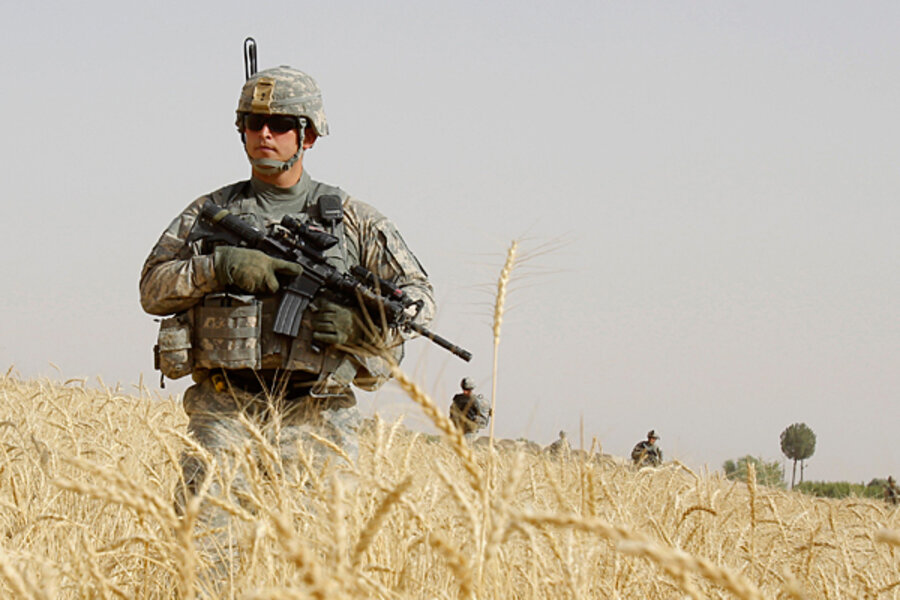Deadliest month yet for NATO in Afghanistan
Loading...
• A daily summary of global reports on security issues.
More than 100 foreign troops fighting in Afghanistan have already died in June, making it the deadliest month to date in the nine-year war, according to independent monitor icasualties.org. Sources differ on the whether the increase in deaths is because of new Taliban techniques or recent military offensives in militant strongholds.
The high death count comes amid growing debate in the US on the prosecution of the war, in particular over strict rules of engagement for US soldiers. The rules have been credited with reducing civilian deaths, but some have criticized them for exposing troops to more danger.
The website icasualties.org is operated by a US-based monitor who aggregates information from news reports and military press releases. Its death toll is often higher than the official death toll, and AFP notes that NATO officially puts its June death toll at 81. This still exceeds the previous high, of 77 troop deaths in August 2009.
By contrast to the 101 NATO forces killed in June 2010, only 51 troops died last month, and only 37 died in the same period one year ago, according to icasualties.org. The site puts the 2010 death toll at 320, compared to 520 in all of 2009. (See a chart of Afghanistan casualties.)
NATO says higher casualties are due to a different, more dangerous phase of the war, according to Agence France-Presse:
NATO has said the dramatic upswing in casualty numbers has been caused by the alliance stepping up military operations and taking the fight to the Taliban in areas where the Islamist militia has previously been unchallenged.
The heavy toll can be largely attributed to the Taliban's use of homemade bombs, or improvised explosive devices (IEDs), which are cheap and easy to make and account for the majority of foreign troops deaths.
The United Nations reported this month that IED attacks had risen by 94 percent in the first four months of this year, compared to the same period in 2009.
The Christian Science Monitor reported this month that the Afghan Taliban has been stepping up the fight with bolder tactics and more frequent attacks. "It is not just the acceleration of the annual fighting season, although across the country the insurgents have telegraphed their intent with a string of raids and bombings. Here in Pashmul, they are trying to suck the foreign forces into a fruitless battle of attrition," according to the Monitor.
Strict rules of engagement for US troops are part of a counter-insurgency strategy formed over the past year with the aim of winning over the Afghan civilian population and eroding local support for the Taliban.
Earlier this month, a top coalition spokesman said the rules of engagement had resulted in "relatively fewer civilian casualties," according to Reuters:
Presenting data from the last three months compared to the same period in 2009, ISAF spokesman Brigadier-General Josef Blotz said there were 7.8 percent fewer clashes involving civilians, with 44.4 percent fewer killed or wounded by coalition troops.
"There is more oversight. There is better training and education," Blotz said in explanation. ...
Some 82 percent fewer civilians have been falling casualty to ISAF air strikes, and 52 percent fewer have been accidentally shot by coalition troops, Blotz told a press conference.
Asked about spiking casualties of foreign troops, mostly Americans, Blotz attributed that to the recent insertion of 39,000 new troops near Taliban-held areas. "The higher number of forces leads to a higher number of confrontations and, unfortunately, to higher casualties," he said. "It has to be tougher before it gets easier, and that is the situation we are in."
But the strict rules of engagement have been a bone of contention for US troops. One of the leading US proponents of those rules, as part of a broader counter-insurgency plan dubbed COIN, was Gen. Stanley McChrystal, former commander of US and NATO forces in Afghanistan. He was fired last week amid the furor over remarks he made in a now infamous Rolling Stone profile that disparaged his civilian bosses.
In that article, a former special forces operator and several soldiers complained about the rules of engagement:
But however strategic they may be, McChrystal's new marching orders have caused an intense backlash among his own troops. Being told to hold their fire, soldiers complain, puts them in greater danger. "Bottom line?" says a former Special Forces operator who has spent years in Iraq and Afghanistan. "I would love to kick McChrystal in the [deleted]. His rules of engagement put soldiers' lives in even greater danger. Every real soldier will tell you the same thing."
FOX News reported that McChrystal's replacement, Gen. David Petraeus, may loosen the rules of engagement to give troops more leeway, citing an anonymous source close to Petraeus. But a General Petraeus spokesman quickly dismissed that report, FOX said.
Petraeus heads to the US Senate today for confirmation hearings.
Related:





